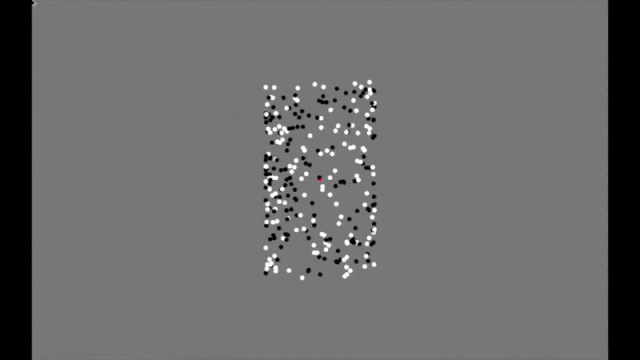This Optical Illusion Could Help to Diagnose Autism
Posted on Categories Discover Magazine

You probably see a cylinder when you look at the illusion above. But how our brains translate two intersecting sheets of moving dots into a 3D image reveals telling differences in visual perception that could perhaps help diagnose autism spectrum disorder.
It’s been shown that people with autism are better at picking out the details of complex images, at the cost of understanding what all those details mean when put together. This can mean seeing the trees, but not the forest, or the strokes of a paintbrush but not the subject of a painting. It’s a trait that’s supported by years of research, but it can be difficult to assess exactly how an individual perceives an image just by asking them questions. The cylinder illusion, applied here by a group of researchers from Italy and Australia, offers a more reliable way of telling what a subject is seeing.
Grow and Shrink
It comes down to the pupils. Our pupils are responsive to light, but they also widen and constrict in response to the notion of brightness or darkness, even if light levels remains the same. Here, the white dots are perceived as brighter, and the black dots as darker, and our pupils respond accordingly. It’s a way for the researchers to tell what parts of the illusion study participants are focusing on. They published their findings in March in the journal eLife.
The illusion itself relies on our brain’s assumptions of how a rotating cylinder behaves. The dots cross over each other just as marks on a transparent cylinder would, they even slow down at the edges to give the impression of curvature. The two colors give imply depth, though a closer look reveals that neither actually seems to be in front — some white dots cross over black dots, and some black over white. It allows us to reverse the cylinder’s apparent direction by focusing on one color over the other. Importantly for the researchers, the illusion is composed of both discrete details in the form of the dots, and a holistic image, in the form of the cylinder. Having both allows them to see which component their study participants favor.
They asked 50 adults, none of whom had autism, to watch the illusion, and while they were doing so, the researchers were watching them — their pupils at least. They wanted to see whether their pupils changed size rapidly throughout the experiment or stayed the same. If they changed size, it indicated that the participants were switching focus back and forth between the white and the black dots — i.e. they were focused on the details of the images. If their pupils stayed about the same, they were likely focused on both at once, meaning they saw the image as a whole. Crucially, both methods of perception produce the same cylinder illusion. But how they do so differs.
Detail-oriented
Before taking the test, the subjects all took the autism spectrum quotient, a self-reported questionnaire that measures various behaviors associated with autism. Higher scores indicate more correlation with autistic traits. When they paired scores on the test with measurements of pupil dilation and contraction, they saw that they were clearly related. Those whose pupils changed with greater frequency also reported more autistic traits. It was another validation of the theory that those with autism tend to focus on specific details as opposed to entire images.
Remember, none of the subjects had been formally diagnosed with autism, and none of their scores on the test indicated that they should be. In fact, the mean value of the test scores was about average. But, autism is a spectrum, and we all lie on it somewhere. Even in nominally average individuals, a tendency toward autistic traits was associated with a propensity to focus on details over holistic images. It adds further evidence that autism alters how we process visual information, and hints that it extends beyond those diagnosed with the disorder. The researchers say measuring changes in pupil size could potentially serve as another means of diagnosing autism.
The results are still a bit preliminary, so it’s too soon to draw definite conclusions based on their work. The surveys were all self-reported, for one thing, which can skew results a bit. And the study involved participants without autism, meaning that we’d need to see similar work in those with autism spectrum disorder to back up their findings.
But, with more research, the authors think their research could be used to perform assessments of those with autism who are non-verbal, which can happen in children. It would give doctors and teachers a way to get information from those who may not be able to communicate it themselves.